Black leg in tomato seedlings: causes of appearance, prevention and control measures
Unfortunately, perhaps every gardener has encountered this dangerous disease when growing seedlings. How offensive it becomes when completely healthy young plants suddenly begin to lie down, and this happens literally in a matter of days (even hours). Indeed, a black leg is a real sentence for young seedlings.
Next, you will learn what a black leg of tomatoes is, what conditions stimulate its development and what can be done to prevent its appearance, in other words, how and what to deal with a black leg of seedlings.
Note! Indeed, the black leg affects tomatoes especially strongly, and also peppers and eggplants, physalis (nightshade crops), however, other vegetable (cabbage, cucumbers) and flower crops (petunias, viola and many others. others).
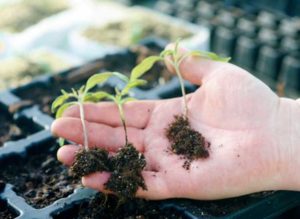
Content
- 1 What is black leg
- 2 Reasons for the appearance of a black leg in seedlings of tomatoes and other crops
- 3 What to do if you find a black-legged plant
- 4 How to deal with blackleg tomato seedlings: prevention and control measures
- 5 How to properly care for tomato seedlings so that they are not hit by a black leg
What is black leg
Black leg of tomato Is a dangerous disease caused by numerous types of pathogenic bacteria and fungiliving in soil.
Causative agents black leg: Peсtobacterium (Erwinia) carotovorum subsp. atrosepticum, Phytophthora infestans de Bary A., Pythium debaryanum, Pythium ultimum Trow., Rhizoctonia solani J.G. Kuhn and Thanatephorus cucumeris.
When does it appear?
- You violated the conditions for growing and keeping seedlings.
- Accordingly, the black leg can affect your seedlings, both immediately after germination and unfolding of the cotyledonous leaves, and after the appearance of real leaves. As a rule, a black leg appears precisely at the initial stage of growing seedlings, after the emergence of seedlings.
How does the black leg appear?
- A clear sign of the defeat of black leg seedlings is the formation dark isthmus (constriction) at the base of the stem, you can also say darkening in the area of the root collar, which ultimately leads to lodging of plants (the stem rots, softens and breaks = seedlings wither and die).
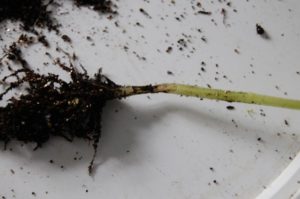
Important! If your tomato seedlings the stem turned purple, then the reason is different.
The main danger of this disease is that, if one plant is infected, then all neighboring ones can get sick... Accordingly, if you do not take action promptly, you can lose all seedlings.
Note! The black leg should not be treated, but prevented by various preventive measures, and then your seedlings will be healthy.
Reasons for the appearance of a black leg in seedlings of tomatoes and other crops
As we have already found out, pathogens, as a rule, are always in the soil (of course, if you have not disinfection), however, the activation of their harmful activity does not occur by itself, but under favorable conditions (violation of the rules of growing and the conditions for keeping seedlings) in the soil-air zone (where the root collar of the plant stem is located).
So, the optimal (favorable) conditions for the emergence and development of black leg seedlings are:
- excessive waterlogging of the topsoil (high humidity);
- and lower temperature of the content (including strong temperature drops when the soil cools down significantly).
Simply put, when seedlings cold and humid, more precisely, the ground is cold and wet.
Cold windowsill, drafts ...
Video: black leg of seedlings - what is it, what contributes to its appearance and how to deal with it
What to do if you find a black-legged plant
All you can do is remove the black-legged plant as soon as possible, from the total capacity, and then:
- Spill the remaining seedlings with one of the fungicidal agents and hope that the disease does not spread to neighboring ones.
If possible, preferably as soon as possible cut open (transplant) healthy seedlings into new containers and disinfected soil.
- And of course, eliminate the cause of its appearance, namely improve the conditions for keeping seedlings (increase the temperature, lower the humidity, loosen the soil).
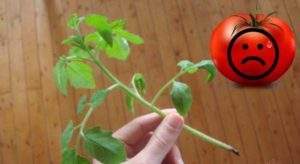
Of course you can try to cure diseased seedlings, for example, using a biological drug, for example, Glyocladin or Fitosporin in a higher concentration (double or triple dose), from chemical - Previkur, Fundazol, Maxim. However, the probability of recovery is rather low ...
How to deal with blackleg tomato seedlings: prevention and control measures
Obviously, any disease is easier to prevent (prevent) than to cure later. Moreover, in the case of the black leg, in principle, it will probably not be possible to cure it ... Accordingly, you should take preventive measures to protect the seedlings from the appearance of the black leg.
Correct soil preparation (disinfection)
Soil disinfection will allow you to immediately get rid of most of the pathogenic fungi and bacteria.
Moreover, this applies to both self-prepared soil mixture and purchased soil.
The soil can be disinfected thermally, namely:
- steam (hold over steam);
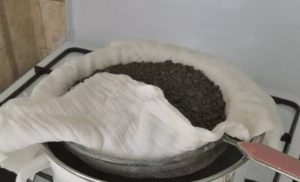
- bake in the oven.
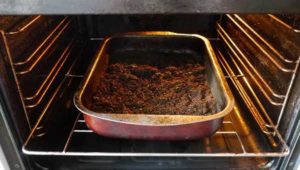
However! It should be borne in mind that calcining (heating) the soil at high temperatures (above 200 degrees) will lead to the fact that many beneficial microorganisms will die in it ...
Advice! To restore the soil microflora, you can spill the soil with one of the biological agents (the same Fitosporin, or EM preparations, such as Baikal or Shine). Moreover, this must be done at least a week before its (soil) use, so that the earth has time to be saturated with beneficial microorganisms.
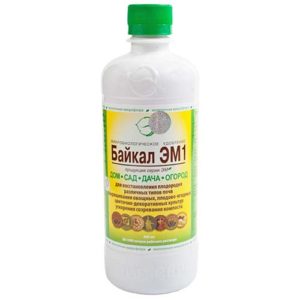
Preparations for protection against blackleg
To disinfect the soil, you can also spill with fungicidal solution... For example, a saturated solution of potassium permanganate (which is very ineffective), the drug Fitosporin, Previkur, Healthy Land. There is also an opinion that Fundazol and Maxim help well against the black leg.
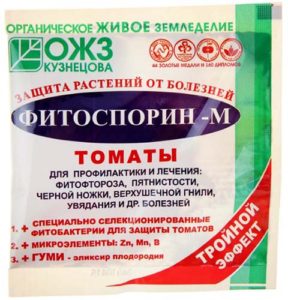
Advice! For blackleg prevention, you can also spill seedlings with solutions of these drugs during its growth.
The same preparation "Zdorovaya Zemlya" is used to disinfect the soil by irrigation after sowing the seeds.
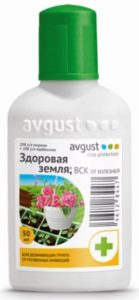
As an additional protective measure, you can place (deepen) a tablet of one of the special fungicidal agents into the soil, for example, Glyocladin.
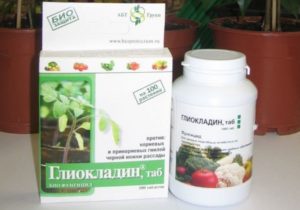
Similar to the use of Glyocladin, you can use Alirin and Gamair.
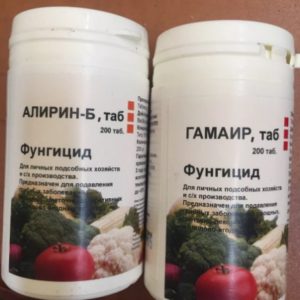
Seed treatment before planting
It is believed that the black leg prevention measures include pre-sowing seed preparation, which will at least help to increase the immunity and resistance of future plants to pathogens.
By the way! There are articles on the site for pre-planting seed treatment of various crops: tomato and peppers.
How to properly care for tomato seedlings so that they are not hit by a black leg
As we have already found out, the black leg appears and actively develops in favorable conditions for this. Accordingly, you need to observe the following rules for the care and maintenance of seedlings, and first take preventive measures for the treatment of the soil and planting containers.
- Rinse and disinfect planting containers, make in them drain holes (for draining excess moisture so that the soil does not become waterlogged).
It is even more important to do this if last year you already grew seedlings in these planting containers (pots, cups, plastic containers).
- Use soil suitable for acidity, usually, neutral reaction (pathogens develop more strongly in acidic soil).
To reduce soil acidity can be used wood ash, dolomite flour.
Some gardeners even advise sprinkling the soil around the seedlings with wood ash.
- Moreover, the soil itself should be loose (air and moisture-absorbing)... It is in such soil that moisture will not stagnate.
Dense soil sours easily, becoming a favorable environment for the occurrence and spread of fungal diseases, including blackleg.
- Conduct disinfection of soil (ignite and / or spill with a fungicide), including as an additional protective measure you may place a tablet of one of the fungicidal agents in the soil (for example, Glyocladin).
- Try do not thicken crops and if necessary thin out seedlings (or make a pick).
- Despite the fact that the seedlings do not like cold drafts, normal air circulation (good ventilation), this is one of the basic conditions for the normal development of seedlings.For example, you can remove the seedlings from the windowsill and only then slightly open the window (window), placing them on airing.
Note! In conditions of thickening of seedlings and their poor air flow, the black leg almost instantly affects all seedlings.
- Watch closely behind the temperature seedling maintenance.
The soil should always be warm, soil should not sharp cool down... For example, you can put styrofoam on a windowsill.
- Arrange good lighting. If the daylight hours are short (and in February and March there will be clearly not enough light, all the more often it is cloudy), it is imperative light up seedlingsso that it does not stretch and loosen.
Weakened seedlings with thin elongated stalks are much more easily affected by black leg and other fungal diseases.
- Water properly, namely, to prevent waterlogging of the soil (including there must be good drainage or drainage holes). Watering is recommended rare and abundant, which will make it possible to dry out the top layer of the soil, but remain moisture inside.
The more often you water, the more likely a blackleg will appear.
- Periodically spill seedlings with protective fungicides (same Fitosporin).
By the way! The site has a separate article about how to properly care for tomato seedlings at home.
Well, now you know the symptoms and causes of the appearance of a black leg, which means you can protect your tomato seedlings from being affected by this dangerous disease. In fact, all you need to do is properly prepare the soil by decontaminating it, and then create and maintain favorable conditions for growing seedlings. Let your seedlings grow strong and healthy! Good luck!
Interesting! The author of the following video offers a very good idea for protecting seedlings from a black leg. Namely you need sprinkle seeds (shoots) with river sand, due to which the earth (sand) in the area of the root collar will always be dry (because sand dries out faster than the same peat soil).

